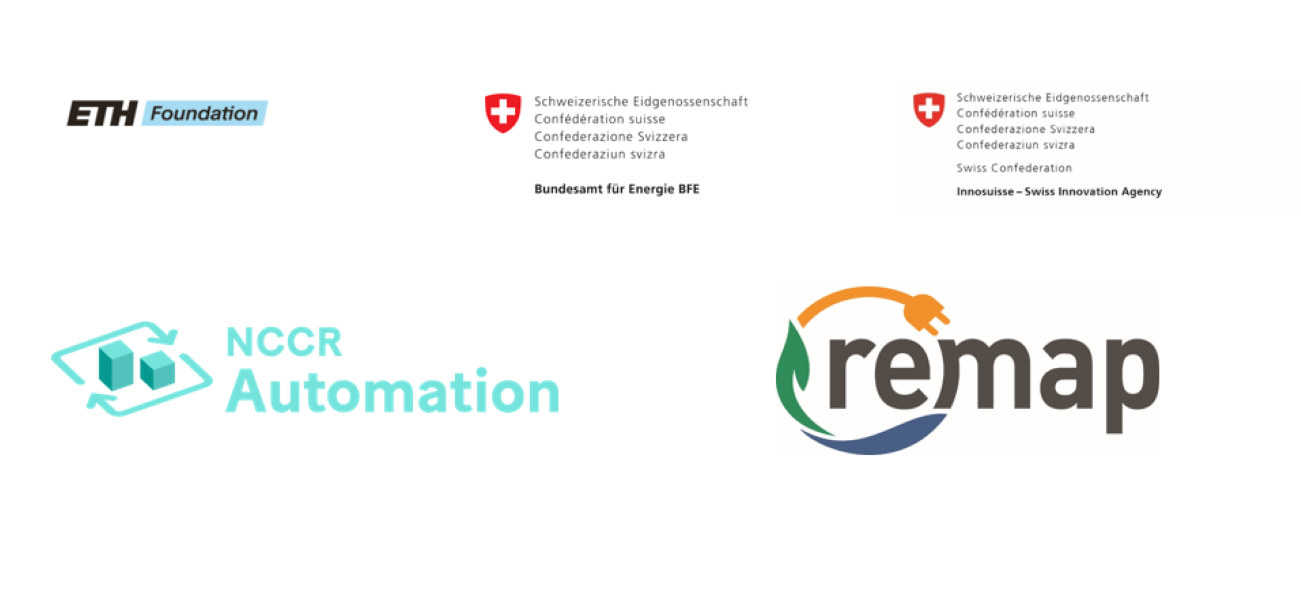Buildings and Energy

Building and district heating and cooling energy amounts to 70% of the total energy demand in households in Switzerland and to more than 44% of the total primary energy consumption worldwide. Efficient control methods can help to significantly reduce this consumption. In our theoretical research, we investigate in the areas of robust and stochastic MPC and system identification. In our applied research, we combine methods from control theory and machine learning to optimally control room temperatures with data-driven controllers, provide electrical reserves with heat pumps and optimally coordinate electrolyzers with H2 storage.

One of the most critical challenges of this century is the increasing global demand for energy and the resulting impact on the environment. Worldwide, the residential and commercial sectors use 2589 Mtoe (mega tonnes of oil equivalent) in energy, which accounts for almost external page 40% of final energy use in the world. In European countries, 76% of this energy goes towards comfort control in buildings - heating, ventilation and air conditioning (HVAC).
This level of consumption makes measures aimed at HVAC energy reduction very attractive. These can be realized by improving a building's HVAC systems and construction, its operation, or preferably some combination of both. Unfortunately, the majority of the building stock is already in place and refurbishments of buildings are expensive. In contrast, the control systems used in the buildings can be upgraded and their operation optimized at comparatively low cost. Our efforts focus on the development, simulation and implementation of model predictive control (MPC) for buildings.
MPC is a promising alternative to standard strategies for building control. It uses a mathematical model of the building and predictions of disturbances (e.g., ambient temperature) over a given prediction horizon (e.g., two days) for defining an optimization problem that is solved such as to maintain thermal comfort for the occupants while minimizing some objective (e.g., energy use or monetary cost). This makes it possible to integrate all available actuators and their interactions as well as predictions of weather, internal gains and electricity prices into a coherent, mathematical control framework that can handle constraints on control inputs and room temperatures. MPC relies on having a model of the building dynamics (which can be difficult to obtain and maintain), and so a new direction of our research involves modeling buildings via neural networks and other data-driven methods.
The following is a list of recent building control projects conducted at the Automatic Control Laboratory.
Research
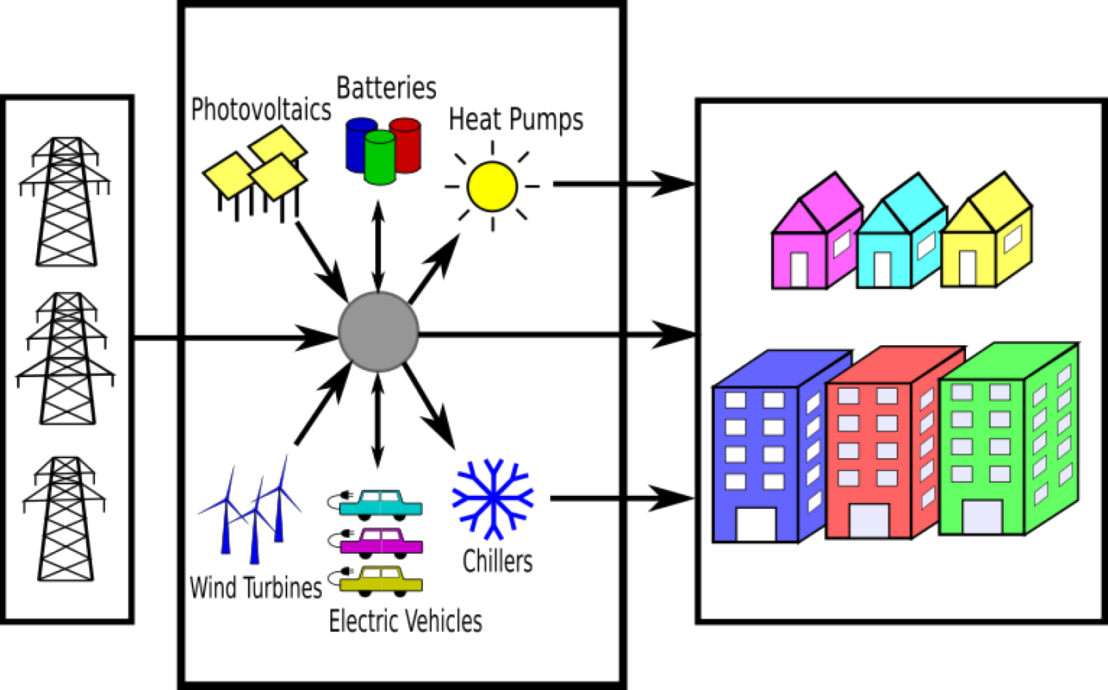
Buildings, and the various energy hub components providing heat and electricity to them, can naturally be controlled at different scales, and our research naturally focuses on various aspects of each scale. For example, control at the single-agent level consists of controlling a single building (or even a subunit of the building), or an energy hub component such as a heat pump. Several such agents, comprising a group of buildings serviced by a local district heating system, form a multi-agent system which can be controlled hierarchically via distributed MPC. Finally, we design techniques for large-scale control at the city-grid level; see also our page on power grid control.
The description of current and past projects in these three paradigms, as well as a section on theoretical methods and software, follows below
Energy hubs and buildings consist of interconnected units that act independently. In order to implement decision and control algorithms to coordinate these systems, one needs models and control paradigms for these individual units. Here, we outline our work in this regard.
Power-to-gas-to-power
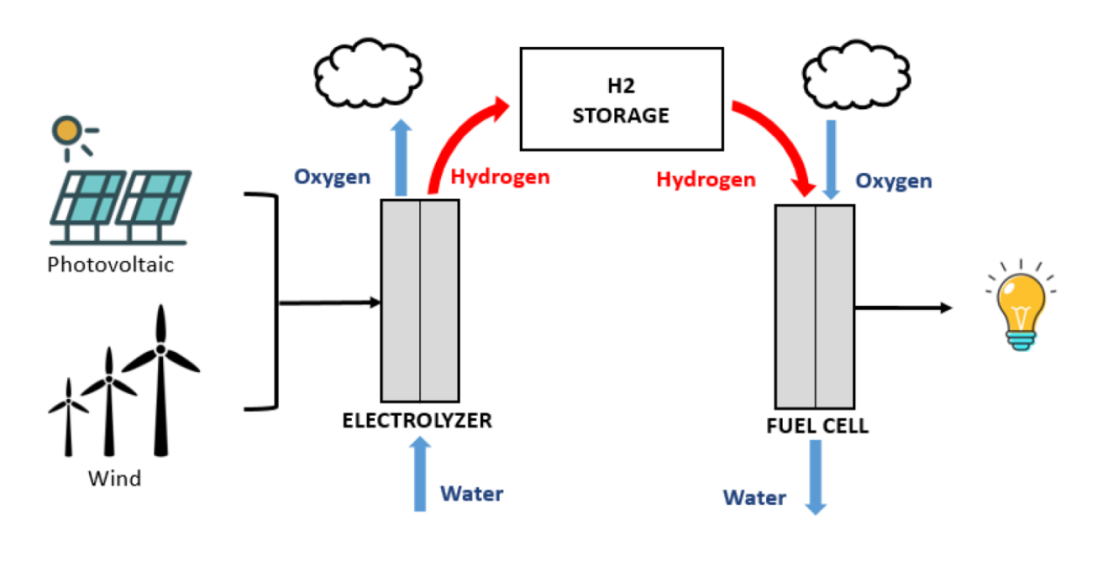
The power-to-gas-to-power (P2G2P) path represents a suitable candidate for long-term energy storage and could help closing the mismatch between renewable energy power generation and local electricity demand on a seasonal level (e.g. storing power produced by sun during summer to be used during winter). The path is composed of an electrolyzer, a storage tank for the hydrogen produced and a fuel cell. Due to the relatively low efficiency of this technology, the optimal control of the system is of fundamental importance in allowing one to reap the benefits of P2G2G in the near future. MPC is a suitable candidate for the optimal control of the P2G2P path. Through the ReMaP project, we aim at developing suitable models for the electrolyzer and fuel cell behavior at the Energy System Integration (ESI) platform at Paul Sherrer Institute (Villigen, CH) and at Move demonstrator at EMPA (Dubendorf, CH) and use such models in optimal control problems.
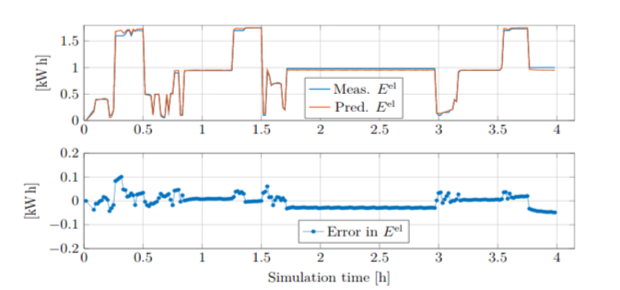
We also focus on developing forecasts for solar power production, wind power production, electricity price and CO2 intensity of electricity by exploring different artificial neural network architectures. The developed models and forecasts are used in different optimal control problems, both in a deterministic and in a stochastic framework: from price arbitrage [20] and optimal bidding strategies, to cost [21] or CO2 emissions minimization during operations, to stochastic multi-period peak shaving [22]. In the ESI and Move platforms, we are able to implement our algorithms in a unique setting, providing experimental validation to our methods.
Data driven control for residential buildings [6,7]
The aim of data-driven control is to do predictive control of heating and cooling systems for residential buildings with minimal modelling effort. The motivation for this project is that there is a significant untapped potential for energy savings through energy-efficient control in residential buildings, which is currently not exploited due to high modelling costs. We investigate and develop a variety of data-driven approaches, for example based on Random Forests, Input Convex Neural Networks, Data-Enabled Predictive Control, and ARX models with a data-driven solar gains model in experiment and compare them to more conventional approaches such as Resistor-Capacitor representations of the buildings' thermal dynamics.

Figure 3 shows an example of room temperature trajectories and cooling energy consumption from an experiment in an apartment unit at the Nest building. Here, a data-driven predictive controller is compared to standard hysteresis room temperature control. The predictive controller saves around 25% of energy while achieving better room climate.
Model predictive control of a Swiss office building [10]
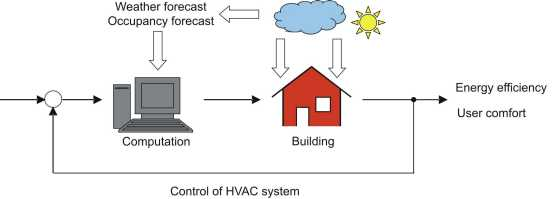
In Phase I of the external page OptiControl project, the potential of model predictive control strategies was assessed in simulations. For a large set of building/systems/weather combinations, whole year simulations of industry standard rule-based controller (RBC) and MPC were performed. Validated one-zone bilinear resistance-capacitance type models were used. The simulations showed that (assuming no model-mismatch), MPC can in many cases save significant amounts (~20%) of control energy.
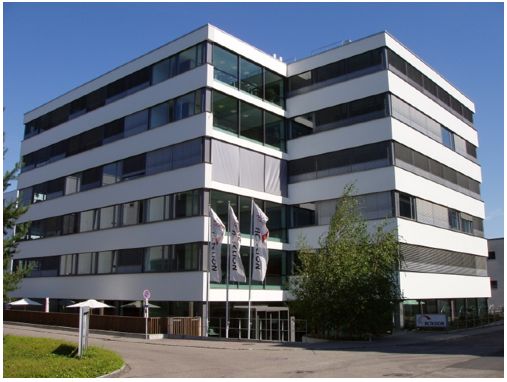
Phase II of the external page OptiControl project provided a proof-of-concept for the integrated control of a whole office building. It addressed problems such as the modeling of real buildings, plant-model mismatch and compatibility with pre-installed control systems. On a typical Swiss office building shown above with a conditioned floor area of ca. 6000 m2, five office floors were controlled for a total period of seven months. The MPC provided integrated control of the TABS, the air handling unit (including energy recovery/heating coil/evaporative cooler), radiators and centrally controlled blinds. MPC was implemented as a high-level controller, sending set-points and operating modes to the existing low-level control. The control algorithm ran in Matlab on a PC, connected through a BACnet-OPC client to the building automation system.
Figure 4 shows the spring/summer experimental period [10]. The maximum (over all rooms) measured integrated comfort violations were approximately 10 Kelvin-hours, mostly stemming from the end of June when the cooling system was overwhelmed. Comfort also was maintained in the heating season experiments (not shown). This was underlined by the facility manager’s feedback.

System identification methods were used to model a ventilated room (with either constant air flow or constant supply temperature). An office type test room was instrumented for experiments and three models for the room were derived: i) an empirical transfer function estimate (ETFE) derived from a pseudo-random binary sequence input signal; ii) an ETFE derived from a relay feedback approach; iii) a model generated with the BRCM Toolbox. The effect of air mixing dynamics was demonstrated in a further experiment to be one of the main differences between the experimentally identified and the RC model.

Large-scale energy hub systems can often be compartmentalized into small, cooperative groups of a few units. We have several projects that tackle theoretical, practical and experimental questions on how control architectures facilitate this cooperation.
Distributed model-predictive control for multiple apartments and an energy hub

The purpose of this project is to demonstrate the feasibility of using distributed MPC controllers, one for each of two apartments, and one for a heat pump, to control the temperature in a real-world building. We are utilizing an Alternating-Direction Method of Multipliers (ADMM) approach to distribute a centralized MPC problem incorporating the apartments and heat pump so that each unit can simply broadcast its heat demands to the pump iteratively, until the apartments agree on a heat input with the heat pump’s output. The method is being demonstrated on the external page NEST building in collaboration with EMPA.
There are two primary reasons why distributed MPC is necessary when deploying these controllers in practice. Firstly, the centralized problem scales poorly when adding additional apartment units and energy hubs - this scaling places a hard limit on the number of units and energy hubs that one can collectively control in a centralized manner. Distributing the computational load to each individual unit effectively bypasses this scaling problem. Secondly, the centralized computation requires direct sensing of temperatures in rooms to be fed to a central computational node - this can violate the privacy of the occupants. By keeping the computation local to the apartment, a minimum of information (the energy demand) is passed to the heat pump, preserving the privacy of the occupants.
Further research directions are exploring the tradeoffs between speed and accuracy (suboptimal MPC), as well as model-free approaches, such as distributed feedback optimization.
Electrical reserves with buildings [1,2,3,4,5]
The increase in the renewable energy sources connected to the electricity grid has resulted in an increased need for frequency regulation. On the demand side, frequency regulation services can be provided by electrified heating/cooling systems exploiting the energy stored in thermal mass of buildings or in buffer storage. Here, we use a solution based on robust optimization and heating demand forecasts with Artificial Neural Networks to offer frequency regulation reserves with such a system comprising a heat pump, a warm water buffer tank, and heating demand from a building that needs to be served. We mitigate the problem of limited thermal storage by introducing affine policies on uncertain variables in the optimization problem. In experiments at the NEST demonstrator building, we are able to offer electrical reserves under real operation of the system.
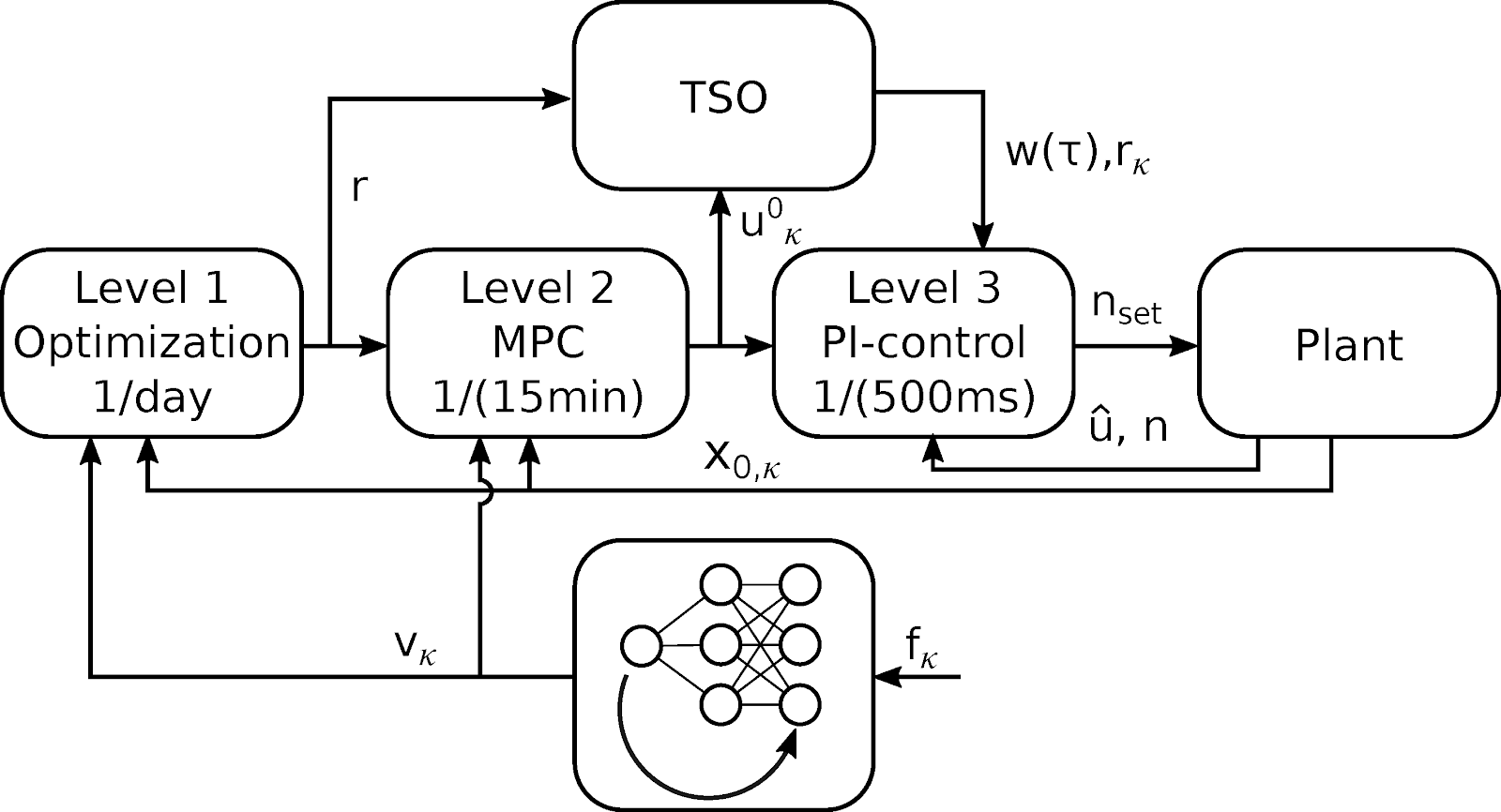
We use a three-level control scheme in this work. In Level 1, a robust optimization scheme with affine policies is used to optimally determine the offered electrical reserves, which are offered to the transmission system operator (TSO). The optimization contains a model of the heat pump and the buffer storage. Moreover, a heating demand forecast, which is done with online-corrected Artificial Neural Networks, is used. In Level 2, the base-load of the heat pump can be adjusted with the help of a Model Predictive Control Scheme. Level 3 is a PI controller, which tracks the regulation signal, which is broadcasted from the TSO.

Figure 8 illustrates an excerpt from the experimental results. It can be seen that the storage temperature stays between two bounds at all times, which means that the heating demand of the building can always be met. Moreover, the heat pump regulates up and down, depending on the regulation signal and the offered reserves.
When the number of cooperative units in an energy hub system becomes large, for example on a city-wide scale, the size of the resulting networked system necessitates novel control strategies. We highlight here some approaches to decentralized and distributed control for energy systems.
Distributed and decentralized control for large-scale energy hub networks [8,9]
Energy hubs are large-scale systems consisting of a set of energy generation, conversion and storage components. Controlling such systems using centralized control can have several drawbacks due to communication and computation complications. In order to avoid such drawbacks, distributed and decentralized control schemes are developed where the large-scale system is decomposed into several subsystems and a local controller is developed for each. In the context of an energy hub, each subsystem might represent a certain energy component. Distributed and decentralized control schemes are also known for their scalability, robustness against failures and flexibility in dealing with varying-topology networks. Furthermore, distributed and decentralized model predictive control schemes handle the control requirements in a systematic manner while considering state and input constraints. Thus, developing novel distributed and decentralized MPC schemes are of great importance and benefit in the field of energy hub control.
Decentralized control of multi-energy systems
Multi-energy system perspectives in district and/or urban areas are core to carbon neutral societies. These systems incorporate electrical, thermal and chemical processes that follow individual demand and supply patterns under distinct time scales, i.e. from sub-second (electrical) to weekly (thermal) and seasonal (chemical) applications. Coordination of the related technologies in the domain of energy systems can only be achieved by optimally controlling the envisioned technology setup, under current or future stakeholder interests. This includes decentral control setups with restricted information propagation between stakeholders, working with measured data for modelling, controller synthesis and showcasing developments on operating real-life systems. In addition to sector specific technological limitations, the systemic coupling of energy carriers needs to account for the coupling of different time scales as well as different production and consumption patterns.
A decentralized technological landscape facilitates faster computation and reduces the need for extending large-scale infrastructure, such as transmission grids or international imports of energy. This results in more stakeholders being involved in the energetic supply chain that can benefit if they share information on their capabilities and intended production and consumption, which can then be matched locally. The goal of this project is to develop novel distributed control methods for operational decision making in multi-objective management of joint thermal and electrical distribution grids under current and future stakeholder setups that will be fully developed, customized to the multi-energy setting and extended in two directions.
Firstly, we address the coupling of multiple energy streams in urban areas during runtime and optimizing their operational behavior using data-driven control algorithms that can adapt to local specificities by the use of locally gathered measured data and improve system wide optimal behavior in terms of local preferences and privacy. Secondly, we investigate the coupling of agents in these energy grids and the balance between privacy of information and economic/environmental performance using a game theoretic approach for coordinating the decisions of multiple stakeholders. The ultimate goal of this project is to advance widespread acceptance of the coordinated operation of energy system technologies in districts and cities, a key enabling technology in the dynamic next generation multi-energy management systems.
Robust adaptive model predictive control [17-19]
Model predictive control is a popular technique in building climate control, since it can accurately incorporate predictions of the weather and ensure constraint satisfaction. However, the main drawback of MPC is that it depends on a model of the system which can be difficult to obtain. Additionally, any uncertainty associated with the model results in constraint violations and poor performance. Robust adaptive MPC (RAMPC) is a novel method which updates the model of the system online using measurement data. The RAMPC algorithm can be initialized with a coarse model of the system with large parametric uncertainties. The control algorithm guarantees recursive feasibility, while also reducing the uncertainty in the model parameters. RAMPC is particularly suitable for building climate control. This is because identification of the model of a building is a challenging task, while using tools like BRCM to obtain a grey box model with parametric uncertainties is much easier. The benefits of applying RAMPC to building climate control have been demonstrated in [17]. Our current research focuses on improving the RAMPC algorithm to ensure robustness of its performance [18], and to exploit the trade-off between exploration and exploitation in the RAMPC algorithm [19].

BRCM Matlab Toolbox: Model Generation for Model Predictive Building Control [11]
Creating an accurate building model that is simple enough to allow the resulting MPC problem to be tractable is a crucial task in the control development. The building resistance-capacitance modeling (BRCM) Toolbox provides a means for the fast generation of bilinear resistance-capacitance type models from basic geometry, construction and building systems data. It also supports the generation of the corresponding potentially time-varying costs and constraints. The full building model is constructed in a stepwise procedure: i) Automated generation of the building’s linear thermal model (describing the heat transfer between zones, walls and ceilings) from construction and geometry data; ii) modeling of external heat fluxes (e.g. solar gains, building systems, internal gains etc.) using parameterizable modular sub-models; iii) discretization. Several comparisons with the widely used building simulation software EnergyPlus have shown average model discrepancies of around 0.5K over three days (a typical MPC horizon). Moreover it is possible to construct the thermal model directly from EnergyPlus input data files.
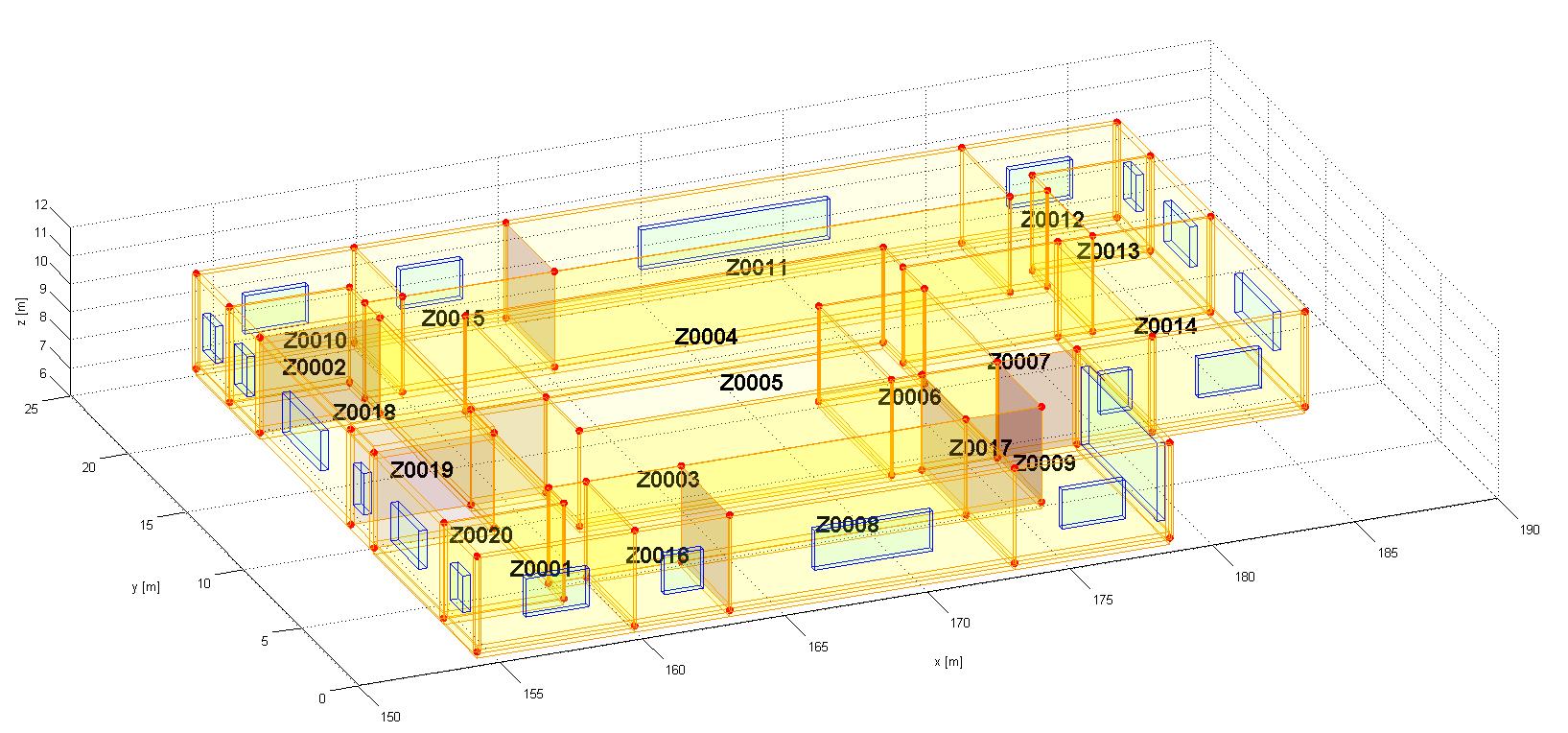
EHCM Matlab Toolbox: Model Generation for a Combined Model Predictive Control Approach [13-16]

Building energy management is an active field of research since the potential in energy savings can be substantial. Nevertheless, the opportunities for large savings within individual buildings can be limited by the flexibility of the installed climate control devices and the individual construction characteristics. The energy hub concept allows one to manage a collection of buildings in a cooperative manner, by providing opportunities for load shifting between buildings and the sharing of expensive but energy efficient equipment housed in the hub, such as heat pumps, boilers, batteries. Typically, control design for the buildings and the energy hub are done separately, underutilizing the potential flexibility provided by the interconnected system. To address these issues, we developed the energy hub component modelling (EHCM) toolbox as a unified framework for controlling the operation of the energy hub and the buildings it connects to. The EHCM Toolbox uses simplified modelling techniques, and modular models built from libraries of commonly used component descriptions, to encourage the adoption of more advanced building control methods.
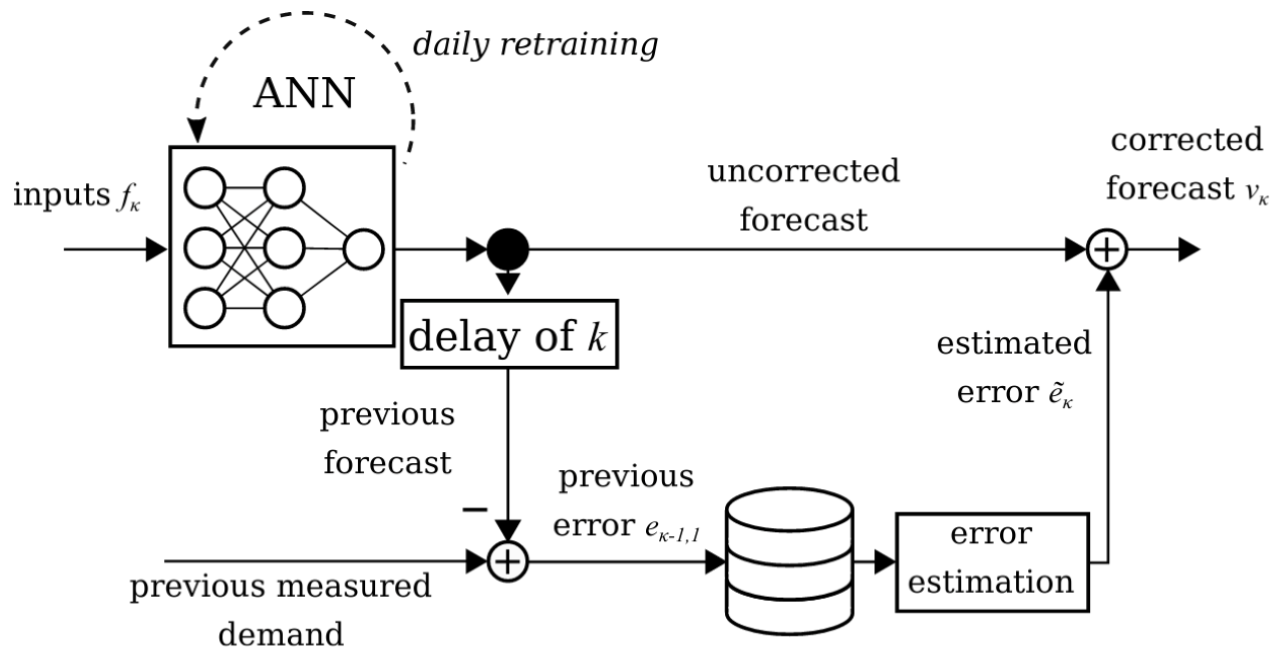
Building automation and control depends on the quality of available weather data, as well as the accuracy of forecasted heating demands. Under the heuristic assumption that forecast errors are correlated over time, we have several works that validate methods of learning demand forecasts and using them in the control loops on live building experiments. In particular, we use a correction based on the autocorrelation of the measured forecasting error of previous forecasts to correct future forecasts [3]. The model is retrained every time new measurements are available. This improves prediction accuracy, but also significantly reduces the variance between different model instances (i.e. reduces the dependency of the network on randomly selected network weight initializations). Sensitivity analysis of the method is performed in [4], and validations on the real-world NEST demonstrator are in [1,5].
People
Professors
-John Lygeros (Head of Automatic Control Laboratory)
-Roy Smith
Postdoc
-Andrea Iannelli
-Mathias Hudoba de Badyn
PhD-candidates
-Ahmed Aboudonia
external page -Varsha Behrunami
-Felix Bünning
-Marta Fochesato
-Mohammad Khosravi
-Francesco Micheli
-Anil Parsi
Visiting PhD student
external page -Giovanni Zanvettor
Publications
[1] Bünning, F., Warrington, J., Heer, P., Smith, R.S. and Lygeros, J., 2020.
Machine learning and robust MPC for frequency regulation with heat pumps. external page arXiv preprint arXiv:2009.06920.
[2] Bünning, F., Warrington, J., Heer, P., Smith, R.S. and Lygeros, J., 2020.
Frequency Regulation with Heat Pumps Using Robust MPC with Affine Policies. Presented at IFAC World Congress 2020.
[3] Bünning, F., Heer, P., Smith, R.S. and Lygeros, J., 2020.
external page Improved day ahead heating demand forecasting by online correction methods. Energy and Buildings, 211, p.109821.
[4] Bünning, F., Heer, P., Smith, R.S. and Lygeros, J., 2019.
November. Sensitivity analysis of data-driven building energy demand forecasts. In Journal of Physics: Conference Series (Vol. 1343, No. 1, p. 012062). IOP Publishing.
[5] Bünning, F., Bollinger, A., Heer, P., Smith, R. and Lygeros, J., 2019.
Empirical validation of a data-driven heating demand simulation with error correction methods. In Proceedings of Building Simulation 2019: 16th Conference of IBPSA (Vol. 16).
[6] Bünning, F., Huber, B., Heer, P., Aboudonia, A. and Lygeros, J., 2020.
external page Experimental demonstration of data predictive control for energy optimization and thermal comfort in buildings. Energy and Buildings, 211, p.109792.
[7] Bünning, F., Schalbetter, A., Aboudonia, A., Hudoba de Badyn, M., Heer, P. and Lygeros, J., 2020.
Input Convex Neural Networks for Building MPC. preprint. external page arXiv preprint arXiv:2011.13227.
[8] Aboudonia, A., Eichler, A. and Lygeros, J., 2020.
Distributed Model Predictive Control with Asymmetric Adaptive Terminal Sets for the Regulation of Large-scale Systems. external page arXiv preprint arXiv:2005.04077.
[9] Aboudonia, A., Eichler, A. and Lygeros, J., 2020.
Distributed Model Predictive Control with Reconfigurable Terminal Ingredients for Reference Tracking. external page arXiv preprint arXiv:2007.00427.
[10] Sturzenegger, Gyalistras, Gwerder, Sagerschnig, Morari, Smith. Model Predictive Control of a Swiss Office Building. 11th REHVA World Congress Clima 2013.
[11] Sturzenegger, Gyalistras, Semeraro, Morari, Smith. BRCM Matlab Toolbox: Model Generation for Model Predictive Building Control. American Control Conference 2014.
[12] Sturzenegger, Keusch, Muffato, Kunz, Smith. Frequency-Domain Identication of a Ventilated Room for MPC. 19th IFAC World Congress.
[13] Georgios Darivianakis, Angelos Georghiou, Roy S Smith, and John Lygeros. A Stochastic Optimization Approach to Cooperative Building Energy Management via an Energy Hub. Proc. Conference on Decision and Control, pages 7814-7819, 2015.
[14] Georgios Darivianakis, Angelos Georghiou, Roy S Smith, and John Lygeros. The Power of Diversity: Data-Driven Robust Predictive Control for Energy Efficient Buildings and Districts. IEEE Transactions on Control Systems Technology, 27(1): 132 - 145, 2019.
[15] Georgios Darivianakis, Angelos Georghiou, Annika Eichler, Roy S Smith, and John Lygeros. Scalability through Decentralization: A Robust Control Approach for the Energy Management of a Building Community. Proc. IFAC World Congress, pages 14879-14884, 2017.
[16] Georgios Darivianakis, Annika Eichler, Roy S Smith, and John Lygeros. A Data-Driven Stochastic Optimization Approach to the Seasonal Storage Energy Management. IEEE Control Systems Letters, 1(2): 394-399, 2017.
[17] Tanaskovic, M., Sturzenegger, D., Smith, R., & Morari, M. (2017). external page Robust adaptive model predictive building climate control. IFAC-PapersOnLine, 50(1), 1871-1876.
[18] Parsi, A., Iannelli, A., Yin, M., Khosravi, M., & Smith, R. S. (2019). Robust adaptive model predictive control with worst-case cost. external page arXiv preprint arXiv:1911.08607.
[19] Parsi, A., Iannelli, A., & Smith, R. S. (2020). Active exploration in adaptive model predictive control. external page arXiv preprint arXiv:2003.14120.
[20] B. Flamm, A. Eichler, R. Smith and J. Lygeros, Price arbitrage using variable-efficiency energy, CISBAT 2019 Conference, IOP Journal of Physics Conference Series, 2019.
[21] B. Flamm, C. Peter, F. Büchi and J. Lygeros, external page Electrolyzer modeling and real-time control for optimized production of hydrogen gas, Applied Energy, vol. 281, p. 116031, 2021.
[22] B. Flamm, G. Ramos, A. Eichler and J. Lygeros, “Multiperiod stochastic peak shaving using storage,” external page arXiv preprint arXiv:2007.02928, 2020.
[23] Belgioioso, G., Liao-McPherson, D., Hudoba de Badyn, M., Bolognani, S., Lygeros, J., and Dörfler, F. Sampled-Data Online Feedback Equilibrium Seeking: Stability and Tracking. external page arXiv preprint arXiv:2103.13988. 2021.
Funding
Support for this project has come from:
external page NCCR Automation
external page InnoSuisse
external page BFE
the ReMaP Project
external page ETH Foundation
